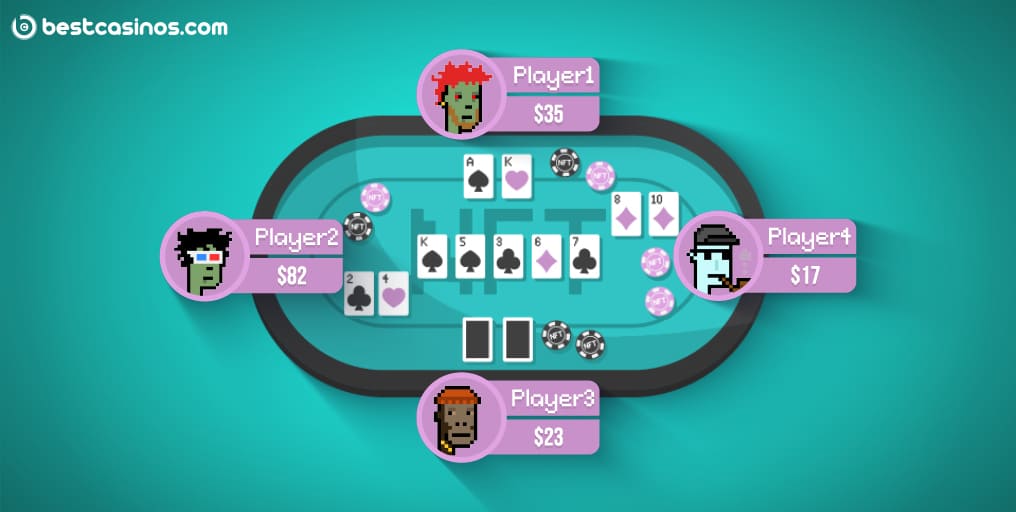
A New Era of Gambling Might Be on the Horizon with NFT Gambling
NFTs, or non-fungible tokens, are taking the world by storm. A term unknown to most of those who aren’t exactly tech-savvy has entered the vocabulary of all internet visitors, and it’s a frequent sight in headlines and articles.
Most recently, NFTs began emerging closely related to gambling, thanks to Evolution’s purchase of four non-fungible tokens and their implementation in the NFT Megaways slot. Seeing NFT gambling or NFT casino games splashed across your favourite casino news outlets must have inspired a tiny bit of curiosity. We are here to help satisfy that curiosity and finally explain what NFT gambling is.
What Is an NFT?
Before explaining what NFT gambling is and where to find NFT casino games, let’s first explain what the concept represents. Let’s start with the term definition:
An NFT (non-fungible token) is a digital unit of data stored on the blockchain. A token uses blockchain technology to establish proof of digital asset ownership, especially those easy to massively reproduce (images, video, audio, etc.). Therefore, NFTs are commonly used as a guarantee of the authenticity of said digital assets.
In simple terms, an NFT is a token representing the originality of a file, while other copies of the original do not fall under the owner’s jurisdiction. Therefore, the owner of a token cannot control the reproduction and sharing of other copies.
But an important aspect of NFTs is the absence of fungibility or the non-interchangeability of the tokens. Tokens are all unique, unlike Bitcoins or fiat currencies. The non-fungibility is the main difference between NFTs and cryptocurrencies like ETC and BTC.
The first NFTs saw the light in 2015 when the first NFT project was launched on the Ethereum blockchain. Since then, token sales have grown in volume and value, reaching €2bn in the first three months of 2021. Compared to the final quarter of 2020, the volume has grown 20 times in size.
It seems these digital tokens are causing waves on the global economic stage, but there are also implications that NFTs are yet to reach their full potential in the years to come. Notwithstanding the carbon footprint and energy costs.
Most Popular Uses
What are these tokens used for? What can you do with a virtual asset that you cannot touch or place in your home? Well, you wouldn’t believe how many possibilities there are now.
From placing them in virtual galleries in virtual worlds to using them as tickets for exclusive events, there’s almost nothing you can do. Music, fashion, film, and sports are all open industries for owners of non-fungible tokens. Here are the most popular uses for non-interchangeable tokens.
Digital Art
One of the main uses – and the one that made tokens famous – is digital art. Each NFT is sui generis, just like art pieces. Hence, they are often collected as digital art, sold and bought for obscene amounts of money. And just like Mona Lisa, the token is purchased and owned by digital art enthusiasts, even though infinite reproductions and variations exist on the internet. But there’s only one Mona Lisa and only one version of each NFT.
In this sense, you would be a digital art collector, one whose collection remains firmly nested on the blockchain rather than your wall. You can also collect them just for the sake of collecting because that’s also quite a profitable hobby.
Tickets for Various Events / Tokens of Appreciation
One specific proposed use of NFTs includes ticketing. Experts proposed using tokens as tickets for events or a source of royalties for authors and artists. It’s not too far-fetched to imagine artists using NFTs as premium-level gifts for the most loyal of fans. Artists with enormous fanbases such as BTS or Ariana Grande could certainly profit from such an enterprise, provided their customers know what NFTs are and how to get them.
Virtual Real Estate
There are also ventures into NFT real estate, mostly active through NFT virtual worlds. What are virtual worlds NFT, you may ask? Those blockchain-based spaces are realities where users buy, showcase, and trade their digital assets and play games and feature tokens in galleries, among other things. These worlds are dubbed the Metaverse, and they represent digital space in which users can perform a variety of activities alone or with friends. An exciting example is the auctioning of virtual land, which is gaining traction as users buy and sell land within those virtual worlds. The most famous example is the sale of the 16-acre piece of virtual land that cost $913,228.20 in June 2021.
Blockchain Gaming
And finally, we reach our destination – NFT gaming. We’ll explore this matter further in our article, but it’s important to note that NFTs fall under the category of blockchain gaming as all things lodged in blockchain. Blockchain is the heart of crypto gaming, covering Bitcoin casinos, Ethereum casinos, and other crypto gambling options.
NFTs are not only implemented into games as in-game features. Non-fungible tokens can also be used as proof of authenticity for the players, which could help minimise processing times for withdrawals. DeFi casinos are also tinkering with the idea of exchanging NF tokens for fiat money (EUR, USD, etc.), which means you could use your NF token as payment for a deposit in a casino in the future. This is still only a concept, though. Our favourite form of NFT gambling is gaming in the Metaverse – a universe of virtual worlds already housing NF tokens. You can play casino games in a Metaverse casino and potentially win NFTs as prizes – which is just the start of this beautiful love story of NFT and gambling.
Metaverse Casino Landscape
With Web 3.0, the use of the internet really, really grew. The possibilities expanded exponentially, and the ways in which we use the internet are impossible to count. One of the ways in which our internet presence changed is the Metaverse.
The Metaverse is a virtual universe consisting of multiple blockchain-based virtual worlds. Each world has the usual paraphernalia – lands, people, and even infrastructure in digital form. Of course, avatars represent people who buy, sell, and own items in their worlds. They can interact with other avatars, attend concerts, buy games, and even – as we’ve shown – showcase their digital art pieces. Moreover, to fully grasp the scope of this digital lifestyle, you’ll be delighted to hear that there are multiple multiverses as well, not just one.
One of the most famous virtual worlds is Decentraland, which lets you build galleries and sell land (for very high prices) and play games. However, Decentraland is one of many worlds in which you can play-to-earn rather than pay-to-play.
The difference between these two models is that play-to-earn lets you earn money through playing the games. Real-world money, to be clear. And therein lies the connection of these games with gambling – by playing in these crypto worlds, you get to earn tokens that can be exchanged for real money.
Metaverse Casinos
It’s not a surprise gambling reached NFT virtual worlds as well. A key example is GamblingApes, a metaverse online casino in which you can play with NFTs and earn them as prizes. GamblingApes is currently just one of many examples of casinos existing in the cryptocurrency realm that bridges the gap between reality and digital reality.
Even Atari, the video game pioneer, has decided to enter the casino business right in Decentraland. The company teamed up with Decentral Games to build a 20-parcel casino estate in the gaming district in Vegas City, Decentraland. Atari Casino visitors get to play Atari-themed games, Atari Token (ATRI) and NFTs as prizes.
The latest to join the NFT casino party is Rollbit, a cryptocurrency casino that is the first-ever casino to launch its NFTs for online casino players. The site launched Rollbots, a collection of 10,000 unique robots built on the Ethereum blockchain. Rollbots are not just art pieces but rather amazing tokens offering top-shelf utility. By owning them, users can create their own Rollboxes and earn passive income, play Rollbot-tied games, access the weekly lottery, and enjoy an enhanced reward program at the casino.
Most Expensive Examples of Non-Fungible Tokens
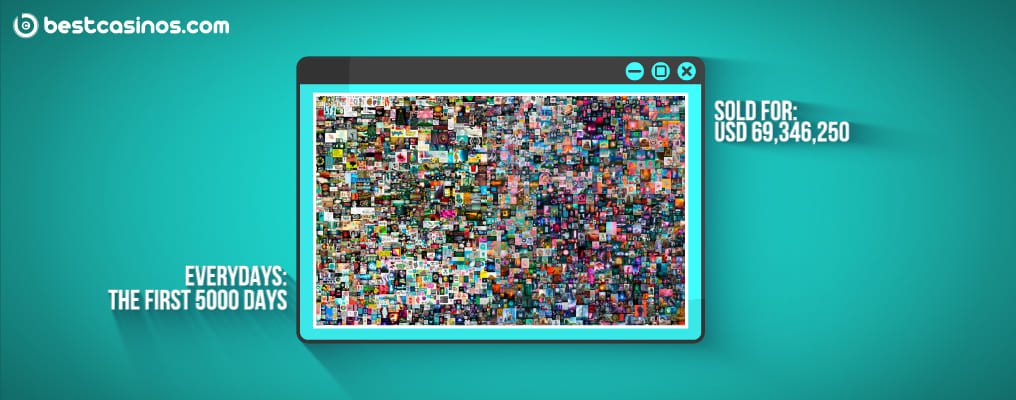
One attractive thing about NFTs is that they can get very expensive. And when we say expensive, we mean millions of dollars exchanged for one single token.
The price tag of each token can be explained as both the cause and effect of its popularity. Moreover, they are taken as a new form of artistic expression, the so-called digital art reformation, already worth millions of dollars.
The most famous examples entail ludicrous amounts of money exchanged for a single token. Also, it’s worth noting that the list of the most expensive NFT transfers is quite long – and updated every month! From June to October this year, the list suffered so many changes that you’ll hardly find a familiar name there. However, the biggest sale ever remains the reign supreme of the NFT sales – the Beeple’s Everydays: The First 5,000 Days, sold at Christie’s for $69.3 million.
First Codes and First Tweets
Another expensive token on the list is Jack Dorsey’s first-ever tweet on the network, published on 21 March 2016. Dorsey, the founder of Twitter, sold the NFT of the tweet “just setting up my twttr” for more than $2.9 million. Deep-pocketed Ethereum wallet users could also get the source code of the World Wide Web. Tim Berners-Lee listed the token for sale in 2020. A year later, it was sold for $5.4 million. A decent sum for the creator of the internet, right?
Mad Dog Jones’ Replicator creates new unique tokens every 28 days – and it looks like a copier as well. The piece was sold for $4.1 million at an auction at Phillips in April 2021. The piece’s value stems from the token creation ability, meaning that the owner gets to have up to 220 new NFTs to own or sell.
The list also includes CryptoPunks, charming characters that the American company Larva Labs created in 2017 on the Ethereum blockchain. They are a key ingredient of this story as they represent the moment the gambling industry intersects with NFT assets.
CryptoPunks
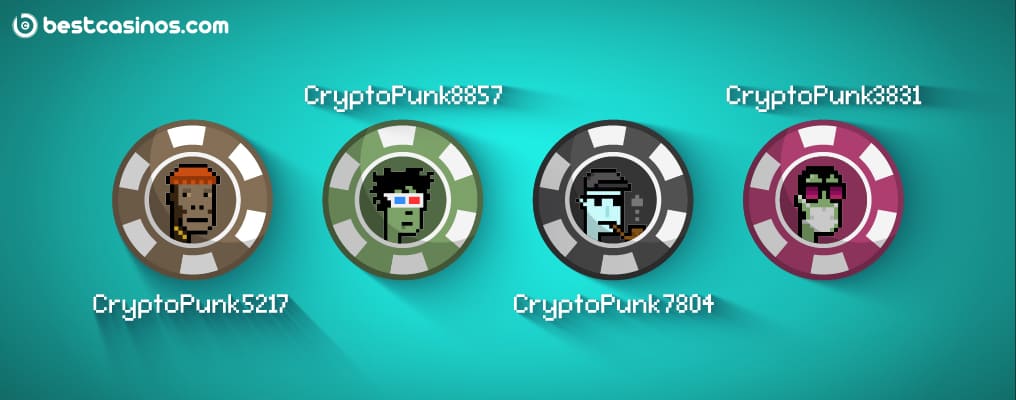
CryptoPunks are some of the earliest examples of non-fungible tokens created by Larva Labs. There are 10,000 of them, each representing a unique collectable character.
Matt Hall and John Watkinson, the founders of CryptoPunks, created an algorithm that produced 10,000 pixelated characters in a bid to create a revolutionary app. Their plan for an app failed, but beautifully – at the time of writing this, the total value of all sales exceeded $1.4 billion.
A quick visit to Larva Labs’ official website will reveal all 10,000 characters and their fates since 2017 when they first appeared. Upon emergence, all punks were free for grabs. Users on the Ethereum blockchain snatched them up for free, provided they had an Ethereum wallet. And from that point, they got owners, so the only way to get them was through a purchase. The owners typically list them for sale when they decide to cash in on their valuable assets, and you can watch the market listings straight from the Ethereum marketplace.
The most expensive sales are #7804 and #3100, which sold for $7.57 million and $7.58 million, respectively. Reportedly, another big sale happened in June 2021, when Israeli billionaire Shalom Mechenzie dished out $11.7 million for punk #7523.
NFT Casino Games Intersection
The point when NFTs became mainstream was when tech-savvy visionaries connected them with gaming. As you know, the gaming industry is one big industry, and it’s expanding as we speak.
Countless innovations, sophisticated tech, software updates, and cutting-edge technologies like VR, AR, and XR are changing the way we perceive gaming. After all, as one of the biggest branches of entertainment, gaming is deeply embedded into the fabrics of everyday life. And the whole situation with the pandemic only pushed it forward and solidified gaming as the hottest industry of today.
Thus, combining the state-of-the-art technology with something revolutionary as NFTs is bound to create a sizzle. And sizzle it does, thanks to the introduction of NFT games.
In our following chapters, we will explore the concept of gaming with NFTs both in casual and real-money gambling games. We will show you some of the most common games to play on the internet at your favourite sites too.
NFT Megaways
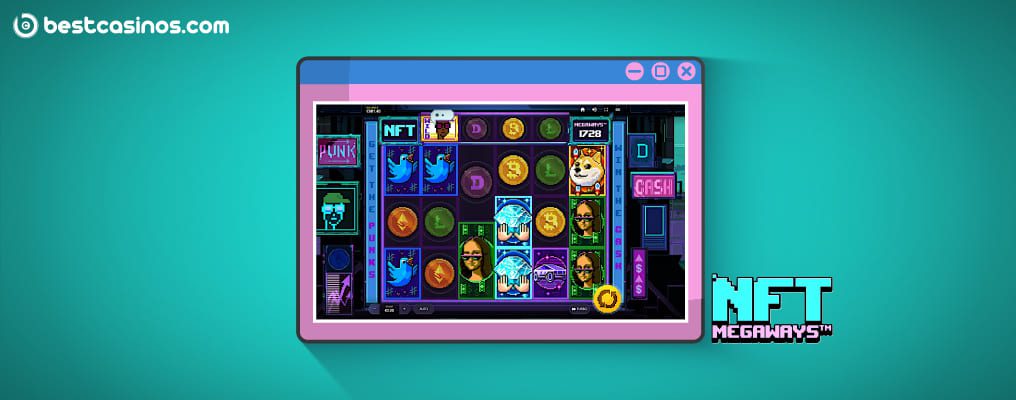
The evolution of NFT gambling games begins with its namesake – Evolution. If you know who’s who in the live casino industry, you must have heard of the industry giant who formerly went by Evolution Gaming.
Namely, Evolution purchased four CryptoPunks NFTs – #3008, #4701, #8143, and #914. The punks are now officially implemented in Red Tiger’s NFT Megaways slot, making it the first NFT slot in history. Thus, the creator of the game did not have to brainstorm about the game title for long. They chose the simple yet effective name for its history-making game to bear. A power move, for sure, given it is a powerful slot using Big Time Gaming’s Megaways mechanics as well.
As you might know, Red Tiger is a NetEnt subsidiary, and Evolution purchased NetEnt (thus gaining Red Tiger as an asset in the process). Several months later, Evolution purchased Big Time Gaming, the owner of the ground-breaking and possibly the most famous game engine in the entire slot industry. This cleared Evolution’s path towards the online slot sector, currently one of the biggest online gambling sectors.
This game launch is amazing in itself because CryptoPunks represent slot Wilds in the game. The presence of Megaways builds the potential of the slot, adding up to 200,704 ways to win. The win potential is capped at 10,000x the stake, more than enough for slot enthusiasts. The game uses many features – Wilds, Multipliers, and Crypto Spins are all very attractive for diehard slot fans. But here’s the thing – the game does not let you win the NFTs. They are there as part of the décor only, at least for now.
NFTs and Cryptocurrencies Correlation
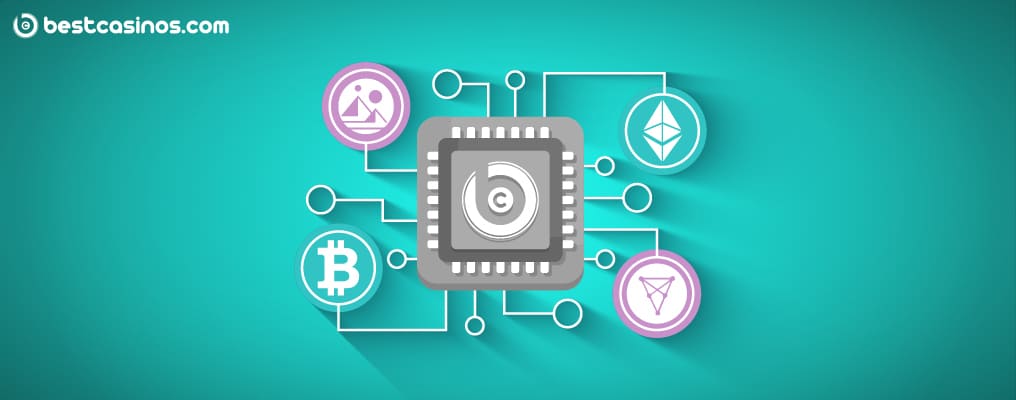
An important question most gamers and crypto enthusiasts might pose is the link between NFTs and cryptocurrencies. Like we already said, both use blockchain as their homeland, but cryptocurrencies are interchangeable. When mining Bitcoins, you can exchange them and use them like any other currency in the world. Two Bitcoins are identical, while non-fungible tokens are not. Each is a unique piece, and the originals cannot be replicated.
But users who are interested in them have noticed a few similarities between using digital currencies and tokens.
NFT Purchasing Versus Bitcoin Betting
Purchasing NFT is a quirky hobby, but it’s a risky one as well. The value of ETH is not stable, nor is the value of each NF token. Hence, by buying them, you always hope you’ll see their value grow before you sell them to another user. In simple English, it’s a gamble.
The same can be said for crypto gambling. Bitcoin has a long history of tumultuous value changes, and wagering with BTC might be a risk for some players. However, here is the catch – virtual worlds are finding new ways to connect them with the real world in a more stable way.
One way is to introduce NFT-to-fiat exchanges, which allow you to earn tokens in-game and then exchange them for USD or EUR. This is better with play-to-earn models, which allow you to collect items in-game that both are useful for the game and outside of it.
The Future of NFT Gambling Games
The rise of NFT gambling is on the horizon. We’ve seen it with Evolution – by launching the NFT slot; the company successfully tested the waters to see whether such a concept would catch on. And as Evolution has a knack for connecting slots with live dealer games – cue in Gonzo’s Treasure Hunt – a possible NFT live dealer table might be in the making as well. However, it is too early for such predictions. We’ll leave it to Evolution to surprise us with another one of its ingenious designs. With the arsenal of software, games, and tech that it has (and several top-shelf subsidiaries), we don’t doubt something is brewing as we speak.
As for others, we don’t doubt other companies will be quick to jump on the bandwagon and join the crypto party. After all, no one would want to miss out on the fun of collecting NFTs that can potentially yield a lot of money. So stay tuned for more news about NFT gambling and NFT casino games – this is just the beginning.













BestCasinos team consists of online casino experts dedicated to spreading their knowledge and experience to a wider audience, all in effort to help even the most inexperienced players gain their footing in this exciting industry.